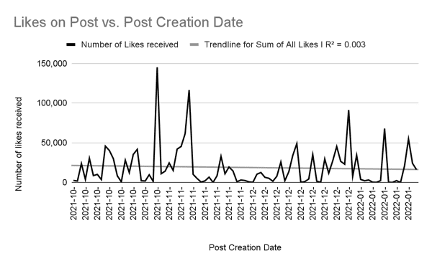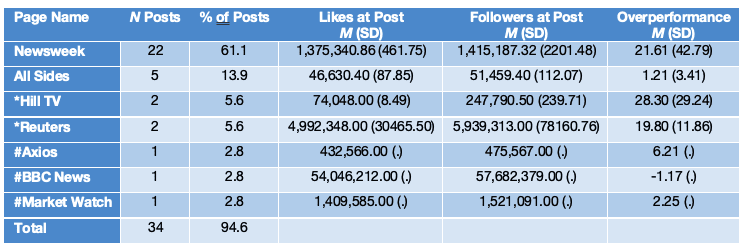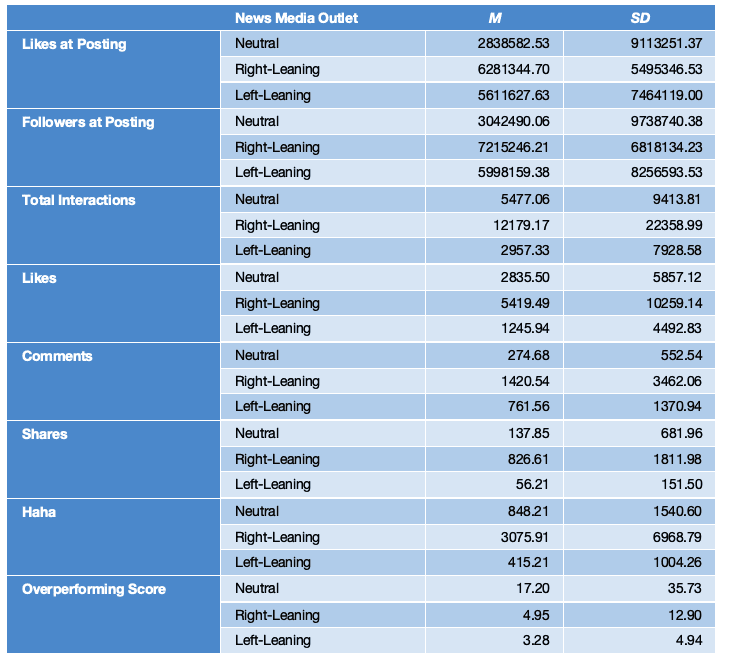Let’s Go, Brandon: An Expression of Disappointment, Partisan Reporting, and Distrust in News Media

Chrysalis L. Wright, PhD
University of Central Florida
Donna Larson
University of Central Florida
Caitlin Rechdan
University of Central Florida
The current study examined potential partisan reporting of the “Let’s Go Brandon” (LGB) phrase using Meta’s metrics platform, CrowdTangle. “Let’s go Brandon” is a euphemism for “f*** Joe Biden,” which is frequently used to express disapproval of President Joe Biden. We tracked posts by news media outlets (right-leaning, left-leaning, neutral) from October 1, 2021, to January 31, 2022. Our study was exploratory in nature, and we aimed to examine patterns and user interactions related to the posts. We found that right-leaning news media outlets were more likely to post about LGB compared to left-leaning and neutral news media outlets and that posts by Fox News had the most user interactions. We also found that right-leaning news media outlets were consistent in their postings related to LGB compared to left-leaning and neutral news media outlets. Results demonstrated that right-leaning news media outlets had more user followers as well as post interactions. Our results also indicated variations in how users interacted with posts based on if it was from a right-leaning, left-leaning, or neutral news media outlet. When it came to overperformance in metrics of reactions, likes, comments, and shares on CrowdTangle (CT) in a given amount of time, neutral news media outlets had the highest level of overperformance compared to both right-leaning and left-leaning news media outlets. Explanations of findings and directions for future research are discussed.
Keywords: partisan reporting, CrowdTangle, Let’s Go Brandon, media distrust

Chrysalis L. Wright, Ph.D. is the Director of the Media & Migration Lab and faculty member in the psychology department at the University of Central Florida. Her research centers around media (broadly defined) and technological influences on developmental processes and behavior. She can be reached at Chrysalis.Wright@ucf.edu.
Donna Larson is a student at the University of Central Florida who’s majoring in clinical psychology. She is specifically interested in the neurological and psychological effects of psychotropic medicine (psychopharmacology), and the significant role these drugs could play in the clinical treatment of mental disorders. She plans to graduate in the Spring of 2022. Following graduation, she plans to attend medical school to pursue psychiatry so she can work with patients and help them cope with the undesirable side effects of psychotropic medicine. Prior to attendance, she plans to gain experience in both medical and research-related fields.
Caitlin Rechdan is a senior at the University of Central Florida. She aims to earn her Bachelor of Science in clinical psychology degree with a minor in philosophy in May 2023. She also plans to earn her PsyD in clinical psychology and later practice as a clinical psychologist.
Author Note:
Chrysalis L. Wright, Department of Psychology, University of Central Florida.
The data presented, the statements made, and the views expressed are solely the responsibility of the authors. Correspondence concerning this article should be addressed to Chrysalis L. Wright, Department of Psychology, University of Central Florida, 4000 Central Florida Blvd, Orlando, FL 32816. E-mail: Chrysalis.Wright@ucf.edu.
Introduction
For years, public views and attitudes on fiscal and social issues have been divided. This concern has been reinforced by news media, especially mainstream news media outlets. Many news media outlets actively display some level of favoritism when it comes to the existing political bipartisanship in the United States. As a result, more consumers are becoming skeptical of what media they consider trustworthy information and what is considered just a perspective retelling of information in line with a certain partisanship. This is a common phenomenon in biased media sources where the same news is presented in contrasting interpretations. These interpretations often lead to consumers selecting alternative media news outlets to express their distrust in high profile media news outlets because the consumers are actively seeking other sources that counters the information presented. For instance, in early October of 2021, a National Broadcasting Company (NBC) reporter misreported what the crowd was chanting during a NASCAR game (Zito, 2021). This event led to a viral trend known as “Let’s go, Brandon” on various social media platforms. Our study focuses on news reporting related to the “Let’s go, Brandon” phrase and examines partisan reporting and news media distrust.
Partisan Reporting
It has been well documented that the way in which hard news frames, or presents, information to consumers is generally biased along partisan lines (Newman et al., 2018; Robison & Mullinix, 2016). The effects of framing have been documented in numerous studies around the world, such as the United States (Chagnon, 2020), South Korea (Mosler & Chang, 2019), Zimbabwe (Matingwina, 2019), Europe (Wallaschek, 2019), and Canada (FiAtova, 2019) to name a few. Framing in hard news has been documented for numerous topics, such as immigration and migration (Abrajano et al., 2017; Fryberg et al., 2012; Timberlake & Williams, 2012; Wallaschek, 2019), abortion (Carmines et al., 2010), the MeToo movement (Cuklanz, 2020), supreme court decisions (Clawson et al., 2003), climate change (Harrison et al., 2020), race issues (Williams et al., 2020), health disparities (LaPoe et al., 2021; Nagler et al., 2016), diet and its impact on health (Morris et al., 2016), the Flint water crisis (Congdon et al., 2020), and the current COVID-19 global pandemic (Alshahrani, 2021; Chung et al., 2021; Hubner, 2021; Jing & Ahn, 2021; Lukacovic, 2020; Myers, 2021; Nwakpu et al., 2020; Ogola, 2020). It can be expected that partisan reporting will continue across various current topics, including reporting of the “Let’s Go Brandon” phrase that began in October 2021.
Essentially, framing can be considered how people develop a specific view of an issue or topic or reorient their thinking about such issue or topic (Chong & Druckman, 2007). Framing in hard news can organize information and add meaning to an event as well as promote a specific political interpretation of such an event (Gamson & Modigliani, 1987; Shah et al., 2002; Tuchman, 1978). In the current study, we specifically examined the “Let’s Go Brandon” event and interpretation of the event based on partisan reporting or framing. The slogan was coined at a racing event when a news reporter misreported what the crowd was chanting during a NASCAR race. Since then, the phrase has been widely used to express disappointment in President Biden’s performance. Research using various designs has found that framing can have a direct impact on consumers by altering their attitudes, behaviors, opinions, and leading to polarization (Chong & Druckman, 2007; Han & Yzer, 2020). Consumers have been found to adopt the frames that have been presented to them when discussing the issue or topic with others (Druckman & Nelson, 2003; Walsh, 2003).
While the early research on framing effects in hard news focused on broadcast media, hard news has made its way to social media platforms in an effort to reach a broader audience. With this move, hard news has continued to frame the information they provide to consumers via social media platforms, such as Facebook (Starr & Oxlad, 2021; Valenzuela & Ramirez, 2017). Some research has examined how social media users interact with such content and have found that users are more likely to share content that focuses on morality but not content that highlights negative economic consequences or conflict (Valenzuela & Ramirez, 2017). More recent research has expanded on this finding and has concluded that social media users are more sensitive to moral frames that emphasize authority/respect, harm/care, and fairness/reciprocity compared to those that do not (Xu et al., 2020).
Distrust in Media
With hard news framing following consumers to social media, the framing in hard news may be part of the reason why there is a rising, widespread distrust of mainstream news media (Citrin & Stoker, 2018; Lee & Hosam, 2020; Newman et al., 2018; Reese, 2019; Stromback et al., 2020). Consumers can identify biased reporting when they are attending to it. However, Wallace and colleagues (2020) found that consumer expectations of position consistency applied to source bias but not source untrustworthiness. Therefore, consumers do not always believe sources that maintain a consistent bias position would yield unreliable information. Recent estimates report that three out of four Americans are skeptical about hard news (Lee & Hosam, 2020). Ognyanova and colleagues (2019) discussed the cause for concern regarding poor trust in U.S. media institutions, highlighting how mainstream news organizations have endured the highest loss of public confidence. This loss of trust leads to a shrinking audience who are no longer attending to hard news. Rather, consumers have become uncertain of where to obtain their news from and often feel unstable and anxious (Stromback et al., 2020).
The increase in alternative news outlets, such as social media (Facebook), has also been related to an increased likelihood of questioning information that comes from hard news sources (Fletcher & Park, 2017; Park et al., 2020; Tsfati & Capella, 2003). Even so, research has found that consumers are at an increased likelihood to doubt news stories that are found on social media platforms (Kalogeropoulos et al., 2019; Williams et al., 2020). This finding could indicate that hard news outlets experience consumer distrust when they migrate to social media with the intent of growing their audience, This growing distrust of hard news could lead to negative effects among consumers, such as a decrease in trusting or believing science (Pechar et al., 2018), increased political polarization (Ladd 2005; 2010), and changing aspects of what is considered truth, fact, and reality (Ariely, 2015; Gronke & Cook, 2007; Hanitzch et al., 2018).
Let’s Go Brandon
The phrase “Let’s go Brandon” originated at a NASCAR race that took place on October 2nd, 2021, at the Talladega Superspeedway in Alabama. As Brandon Brown, a professional stock car racing driver, was being interviewed by NBC Sports reporter Kelli Stavast, audience members behind the two were chanting a phrase. The reporter suggested that the crowd was chanting “Let’s go Brandon” in attempt to congratulate the driver, however, instead, they were chanting “**** Joe Biden” (Zito, 2021). The footage of the interviewer’s misreporting of the slogan went viral virtually overnight. Right-leaning news media reported the “Let’s Go Brandon” phrase was a conservative coded banter to President Joe Biden. Soon, citizens all over the country started using the phrase. The secret slogan meant to defame Biden has sparked not only a social phenomenon, but an internet phenomenon across America.
The Current Study
For the current study, we wanted to examine potential partisan reporting regarding the “Let’s Go Brandon” (LGB) phrase via hard news utilizing the social media platform Facebook to share news information with their online audience. We used Meta’s metrics platform, CrowdTangle, to obtain our data and focused on the time period between when the phrase originated and when it was well reported in mainstream news (October 1, 2021, to January 31, 2022). We also focused on the top five social media news outlets for right-leaning, left-leaning, and neutral news to determine the following:
- Prevalence of online news posts related to the LGB phrase.
- Features and characteristics of the top rated LGB new posts.
- User interaction with the top rated LGB news posts.
- Partisan reporting (frequency, content) of LGB news on social media (right-leaning, left-leaning, neutral).
- User interaction with partisan new reporting of LGB news posts (likes, comments, shares, loves, wow, haha, sad, angry, care).
- Social media audience size of partisan reporting outlets.
- Significant differences in consumer interactions between right-leaning, left-leaning, and neutral news outlets.
- Indications of overperformance (a post’s performance relative to the number of interactions received over time compared to the account’s average post performance) of social media news posts related to LGB among the different news outlets (right-leaning, left-leaning, neutral).
Methods and Data
The data for the current study was derived from Meta’s metrics platform, CrowdTangle. CrowdTangle is a free public insights tool from Meta that allows researchers to examine public content on social media platforms, particularly Facebook, Instagram, and Reddit (CrowdTangle, n. d.a). CrowdTangle covers public pages and groups as well as verified profiles on the platform. It does not provide access to posts via private groups, private or partially private personal profiles, or direct messaging. CrowdTangle maintained the anonymity of platform users and allowed us to examine the trends of public Facebook posts related to the “Let’s Go Brandon” phrase.
We searched CrowdTangle between October 1, 2021, and January 31, 2022, for the queries “Let’s go, Brandon,” “let’s go brandon,” and “lets go brandon nascar” to identify posts on public pages and groups and verified user profiles that contained the phrase. We did not use the acronym “LGB” as a query and only focused on posts made in English. Specifically, we wanted to examine posts from news platforms on social media. In order to accomplish this, we filtered posts based on page category. Page categories are self-determined by the administrators of the Facebook Page. Media News Company is one of the categories that can be selected by Facebook Page administrators and was the page category we used in filtering posts from news media outlets (Crowdangle, n. d.b).
Figure 1 displays the query filter for the data examined in this study for news media outlets. There was a total of 1,968 posts with a total of 5,152,739 interactions. Posts that were not in the English language or had less than 30 interactions were removed from our analyses.
Figure 1. Search Query for News Media Outlets
Analysis
The analysis in the current study focused on the time frame of our searches, which covered the time when the phrase became well-known on social media platforms and was being reported via mainstream news media outlets. This does not mean that social media users have stopped using the phrase “Let’s Go Brandon,” as the phrase is likely to continue to be used by social media users.
For the current study, we were interested in the early phases of the use of the phrase and how its meaning has changed considering that mainstream news media published various reports of the phrase. We aimed to compare right-leaning, left-leaning, and neutral news media outlets in terms of how they reported on the phrase and their reach and interaction among consumers. While CrowdTangle identified a total of 1,968 posts from news media outlets related to the “Let’s Go Brandon” phrase 1,144 posts were included in our analyses due to exclusion of posts that were not in the English language or did not have at least 30 interactions.
In our analysis, we examined the gradual spread of posts related to the “Let’s Go Brandon” phrase, paying attention to the news source of the initial post (right-leaning, left-leaning, neutral news media outlets). This highlighted the way in which news media outlets can amplify online politicized content based on their partisan frame, in much the same way that partisan framing is utilized in offline hard news reporting, leading to polarization among consumers(Benedictis-Kessner et al., 2019). We also examined the overperformance of posts. This is a measure generated by CrowdTangle. It is calculated by comparing expected post benchmarks to new posts created by the page (CrowdTangle, n.d.c).
While our analysis summarizes trends related to the “Let’s Go Brandon” phrase from news media outlets, we also included direct quotes and screen shots from online social media posts as well as outside resources the posts may have linked to. We also identified specific social media accounts that played a vital role in sharing content related to the phrase “Let’s Go Brandon.” We also focused on the number of followers of specific social media pages, groups, and verified profiles had at the time of posting to determine the potential impact of specific posts. While this does not provide an exact account of the number of consumers who saw a particular post, it does provide a general overview of the potential impact of a specific post. Because of this and other shortcomings related to CrowdTangle, our results will likely underestimate the impact of specific social media posts.
Results
News Media Outlets
We included a total of 1,144 posts from news media outlets related to the “Let’s Go Brandon” phrase with a total of 5,148,170 interactions between October 1, 2021, and January 31, 2022. The mean number of likes per post was 1966.5. The page most commonly posting content related to the “Let’s Go Brandon” phrase was The Daily Caller. According to Media Bias/Fact Check (2022a), the Daily Caller has far-right biased reporting with mixed factual reporting However, posts with the most interactions originated from Fox News. Media Bias/Fact Check (2022b) has stated that, Fox News has a right reporting bias with mixed factual reporting and medium credibility. Figure 2 shows likes on posts during this time frame from all news media outlets.
Figure 2. Likes on Posts from News Media Outlets
In October 2021, the post that received the most interactions (228,861) was posted by Fox News. In this post, a Southwest airline pilot’s closing statement was “Let’s go, Brandon” over the plane’s intercom system. The post was shared over 11,000 times and received over 29,000 comments. The post can be found in Figure 3.
Figure 3. Top October 2021 Post
In November 2021, the post that received the most interactions (133,234) was posted by Newsmax. According to Media Bias/Fact Check (2021a), Newsmax has a right reporting bias with mixed factual reporting. In the post, NASCAR President states that he will pursue legal action against entities that try to use “Let’s go, Brandon” as a slogan for their merchandise. The post was shared over 5,000 times and received over 41,000 comments. The post can be found in Figure 4.
Figure 4. Top November 2021 Post
In December 2021, the post that received the most interactions (53,094) was posted by Fox News. In this post, President Biden and first lady Jill Biden’s tracking of Santa Claus on Christmas Eve was depicted. The post was shared over 4,100 times and received over 8,800 comments. The post can be found in Figure 5.
Figure 5. Top December 2021 Post
In January 2022, the post that received the most interactions (51,431) was posted by CNN. According to Media Bias/Fact Check (2022c), CNN has a left reporting bias with mixed factual reporting. In this post, NASCAR has rejected Brandon Brown’s LGB bitcoin sponsorship. The post was shared 997 times and received over 7,900 comments. The post can be found in Figure 6.
Figure 6. Top January 2022 Post
Right-Leaning News Media
CrowdTangle identified 304 posts from right-leaning news media company accounts related to the “Let’s Go Brandon” phrase with a total of 3,702,469 interactions between October 1, 2021, and January 31, 2022. The mean number of likes per post was 5,419. The page most commonly posting content related to the “Let’s Go Brandon” phrase was The Daily Caller, a far-right reporting outlet with mixed factual reporting (Media Bias/Fact Check, 2022a). However, posts with the most likes originated from Fox News, a right reporting outlet with mixed factual reporting and medium credibility (Media Bias/Fact, 2022b). Figure 7 shows likes on posts during this time frame from right-leaning news media outlets. The top five right-leaning news media outlets and information about their posts can be found in Table 1. Table 2 summarizes the interactions from the top five right-leaning news media outlets.
Figure 7. Likes on Posts from Right-Leaning News Media Outlets.
Table 1. Top Five Right-Leaning News Media Outlets
Table 2. Interactions with Top Five Right-Leaning News Media Outlets
Table 2 cont. Interactions with Top Five Right-Leaning News Media Outlets
Left-Leaning News Media
CrowdTangle identified 48 posts from left-leaning news media company accounts related to the “Let’s Go Brandon” phrase with a total of 141,952 interactions between October 1, 2021, and January 31, 2022. The mean number of likes per post was 1,246. The page most commonly posting content related to the “Let’s Go Brandon” phrase was the Huffington Post (HuffPost), which has left-leaning reporting, mixed factual reporting, and medium credibility (Media Bias/Fact Check, 2021b). However, posts with the most likes originated from CNN. According to Media Bias/Fact Check (2022c), CNN also has left-leaning reporting, mixed factual reporting, and medium credibility. Figure 8 shows likes on posts during this time frame from left-leaning news media outlets. The top five left-leaning news media outlets and information about their posts can be found in Table 3. Table 4 summarizes the interactions from the top five left-leaning news media outlets.
Figure 8. Likes on Posts from Left-Leaning News Media Outlets.
Table 3. Top Five Left-Leaning News Media Outlets
Note * indicated two media outlets tied for last place in the top five
Table 4. Interactions with Top Five Left-Leaning News Media Outlets
Note * indicated two media outlets tied for last place in the top five
Table 4 cont. Interactions with Top Five Left-Leaning News Media Outlets
Note * indicated two media outlets tied for last place in the top five
Neutral News Media
CrowdTangle identified 34 posts from neutral news media company accounts related to the “Let’s Go Brandon” phrase with a total of 186,220 interactions between October 1, 2021, and January 31, 2022. The mean number of likes per post was 2,836. The page most commonly posting content related to the “Let’s Go Brandon” phrase was Newsweek, which has a left-center bias reporting, high factual reporting, and high credibility (Media Bias/Fact Check, 2022d). Posts with the most likes also originated from Newsweek. Figure 9 shows likes on posts during this time frame from neutral news media outlets. The top five neutral news media outlets and information about their posts can be found in Table 5. Table 6 summarizes the interactions from the top five neutral news media outlets.
Figure 9. Likes on Posts from Neutral News Media Outlets.
Table 5. Top Five Neutral News Media Outlets
Note * indicated two media outlets tied for third place in the top five
Note # indicated two media outlets tied for last place in the top five
Table 6. Interactions with Top Five Neutral News Media Outlets
Note * indicated two media outlets tied for third place in the top five
Note # indicated two media outlets tied for last place in the top five
Table 6 cont. Interactions with Top Five Neutral News Media Outlets
Note * indicated two media outlets tied for third place in the top five
Note # indicated two media outlets tied for last place in the top five
Comparing News Media Outlets
A multivariate analysis of variance (MANOVA) was conducted to determine if there were any significant differences in consumer interactions with posts and page following from right-leaning, left-leaning, and neutral reporting news media outlets.
We found significant differences based on news media outlet for page likes at posting, F (2, 383) = 4.84, p = .008, η2 = .03, page followers at posting, F (2, 383) = 5.24, p = .006, η2 = .03, total post interactions, F (2, 383) = 5.41, p = .005, η2 = .03, post likes, F (2, 383) = 4.78, p = .009, η2 = .02, post comments, F (2, 383) = 2.70, p = .069, η2 = .01, post shares, F (2, 383) = 6.66, p = .001, η2 = .03, haha reactions to posts, F (2, 383) = 5.18, p = .006, η2 = .03, and overperformance, F (2, 383) = 10.99, p = .001, η2 = .05. Significant differences were not found for love reactions to posts, F (2, 383) = 1.84, p = .16, η2 = .01, wow reactions to posts, F (2, 383) = .88, p = .415, η2 = .01, sad reactions to posts, F (2, 383) = .48, p = .618, η2 = .003, angry reactions to posts, F (2, 383) = .26, p = .775, η2 = .00, or care reactions to posts, F (2, 383) = 1.91, p = .15, η2 = .01. Descriptive statistics for significant differences based on news media outlet can be found in Table 7.
We found that in terms of page following and interactions with posts, right-leaning news media outlets had the highest scores on all measures. However, for overperformance, neutral news media outlets had the highest level of overperformance compared to both right-leaning and left-leaning news media outlets.
Table 7. Significant Differences based on News Media Outlet
Discussion
The current study examined the potential partisan reporting related to the LGB phrase on Facebook. We were particularly interested in how hard news (right-leaning, left-leaning, neutral) posted news stories related to LGB on their Facebook pages. We examined data from Meta’s CrowdTangle for LGB posts from the top five (right-leaning, left-leaning, neutral) news media outlets from October 1, 2021, to January 31, 2022, as that was the time period that the LGB phrase was well reported via mainstream news outlets. We found a total of 1,144 posts with a total of 5,148,170 user interactions. Our study is exploratory in nature. We specifically aimed to determine (1) the prevalence of online news posts related to the LGB phrase, (2) features and characteristics of top LGB posts, (3) user interaction with LGB posts, (4) partisan reporting of LGB news on social media, (5) user interaction with partisan news reporting of LGB posts (likes, comments, shares, loves, wow, haha, sad, angry, care), (6) social media audience of partisan reporting outlets, (7) differences in user interactions between right-leaning, left-leaning, and neutral news outlets, and (8) indications of overperformance of social media news posts related to LGB among the different news outlets (right-leaning, left-leaning, neutral).
Overview of Findings
We found that right-leaning news media outlets were more likely to post about LGB compared to left-leaning and neutral news media outlets. Specifically, The Daily Caller posted about LGB the most. However, posts with the most user interactions came from Fox News. During the time period examined in this study, Fox News posts had the most user interactions twice (October 2021 and December 2021), followed by Newsmax (November, 2021), and CNN (January, 2022).
Right-leaning news media outlets were consistent in their posts related to LGB from October 2021 to January 2022, meaning that they posted about LGB about the same each month. However, left-leaning news media outlets displayed a gradual increase in reporting about LGB, starting off low in October 2021 with a steady increase until early January 2022. Neutral outlets, however, had a gradual decrease in reporting about LGB with high reporting toward the end of October 2021 and a steady decline over time, with the lowest number of posts about LGB in January 2022. These findings highlight clear partisan reporting related to LGB, which was expected and not uncommon (e.g., Newman et al., 2018; Robison & Mullinix, 2016). This may reflect the promotion of a specific political agenda as suggested by the findings of Gamson and Modigliani (1987), Shah and colleagues (2002), and Tuchman (1978). It is likely possible that the goal of the partisan reporting was to promote a specific political interpretation of the event leading to the LGB phrase as well as the use of the phrase itself.
We also examined user interaction of right-leaning, left-leaning, and neutral news media outlet posts related to LGB. We found that in terms of page following and interactions with posts, right-leaning news media outlets had the highest scores on all measures There were also variations in how users interacted with posts based on if it was from a right-leaning, left-leaning, or neutral news media outlet.
For instance, for right-leaning outlets, Fox News had the most followers and received the most likes for their LGB posts. Their posts also elicited the most user interactions (i.e., likes, comments, shares, loves, wow, haha, sad, angry, care) compared to other right-leaning outlets, demonstrating the influence that Fox News may have over their audience compared to other right-leaning news outlets (see Chong & Druckman, 2007; Han & Yzer, 2020). Left-leaning news outlets were not as consistent as right-leaning news outlets in terms of which outlet was the most influential. For left-leaning news outlets, USA had the most followers and received the most likes for their LGB posts. However, posts by CNN elicited the most user interactions (i.e., likes, comments, shares, loves, wow, haha, sad, angry, care), highlighting the similar impact both outlets can have on consumers based on the audience’s engagement with the posts as well as the size of the platform (see Chong & Druckman, 2007; Han & Yzer, 2020).
Interestingly, examining the neutral news media outlets was more convoluted compared to right-leaning and left-leaning due to the distribution of interactions with posts from neutral outlets. As an example, BBC News had the most followers and received the most likes for their LGB posts. User interactions, however, were more disbursed. Axios elicited the most total user interactions as well as likes and angry reactions. Reuters elicited the most wow, haha, sad, and care reactions to posts and the Hill TV elicited the most comments and shares among users. Finally, Newsweek elicited the most love reactions to posts. We also found that when it came to overperformance, neutral news media outlets had the highest level of overperformance compared to both right-leaning and left-leaning news media outlets. These findings may indicate that neutral news media outlets are less likely to have a strong influence on their audience compared to partisan reporting, based on the audience’s engagement with posts and platform sizes (Citrin & Stoker, 2018; Lee & Hosam, 2020; Newman et al., 2018; Reese, 2019; Stromback et al., 2020). These results could also indicate that consumers who follow neutral news media outlets doubt news from partisan news sources and seek unbiased reports related to current events (Kalogeropoulos et al., 2019; Williams et al., 2020).
Limitations and Future Research
While our study demonstrates the partisan reporting of LGB, and the potential influence such reporting can have on consumers, our study is based on data obtained from Meta’s CrowdTangle. Our study cannot fully elaborate on growing consumer distrust based on consumer interaction and following alone. This type of analysis requires more intrusive measures, such as looking into individual user comments, which CrowdTangle’s Meta’s does not provide access to. We specifically examined social media posts on Facebook. The data obtained from CrowdTangle covers public pages and groups as well as verified profiles on the platform, meaning that we were not able to access posts via private groups, private or partially private personal profiles, or direct messaging. This means that our data and results provide only a limited snapshot of the content on Facebook. However, Facebook groups and pages are designed for users to share their opinions and common interests together (Facebook, 2010). Future research should be conducted to provide a broader comparison of social media content and interaction as well as hard news framing via social media.
References
Abrajano, H. Z., & Hassell, H. J. G. (2017). Media framing and partisan identity: The case of immigration coverage and White macropartisanship. Journal of Race, Ethnicity, and Politics, 2(1), 5–34. https://doi.org/10.1017/rep.2016.25
Alshahrani, A. (2021). A frame analysis of the language used by eight US media to describe the role of China and Chinese in spreading COVID-19 during late January to early June 2020. Journal of Language and Linguistic Studies, 17, 1129–1140.
Ariely, G. (2015). Trusting the press and political trust: A conditional relationship. Journal of Elections, Public Opinion and Parties, 25(3), 351–367 doi:10.1080/17457289.2014.997739.
Carmines, G. J. C., & Wagner, M. W. (2010). How abortion became a partisan issue: Media coverage of the interest group-political party connection. Politics & Policy (Statesboro, Ga.), 38(6), 1135–1158. https://doi.org/10.1111/j.1747-1346.2010.00272.x
Chagnon. (2020). It’s a problem of culture (for them): Orientalist framing in news on violence against women. Race and Justice, 10(4), 480–500. https://doi.org/10.1177/2153368718768374
Chong, & Druckman, J. N. (2007). Framing theory. Annual Review of Political Science, 10(1), 103–126. https://doi.org/10.1146/annurev.polisci.10.072805.103054
Chung, A. Y., Jo, H., Lee, J., & Yang, F. (2021). COVID-19 and the political framing of China, nationalism, and borders in the U.S. and South Korean news media. Sociological Perspectives, 1. https://doi.org/10.1177/07311214211005484
Citrin, J., & Stoker, L. (2018). Political trust in a cynical age. Annual Review of Political Science, 21(1), 49–70 doi:10.1146/annurev-polisci-050316-092550.
Clawson, R. A., Strine IV, H., & Waltenburg, E. (2003). Framing supreme court decisions: The mainstream versus the black press. Journal of Black Studies, 33(6), 784–800.
Congdon Jr., M., Quang Ngo, & Young, E. (2020). Environmental injustice: Examining how the New York Times frames the Flint water crisis. Ohio Communication Journal, 58, 12–25.
CrowdTangle (n.d.a). About us. Retrieved from https://help.crowdtangle.com/en/articles/4201940-about-us
CrowdTangle (n.d.b.). FAQ: Page category filter. Retrieved from https://help.crowdtangle.com/en/articles/5367790-faq-page-category-filter
CrowdTangle (n.d.c.). How is overperforming calculated? Retrieved from https://help.crowdtangle.com/en/articles/1141056-how-is-overperforming-calculated
Cuklanz, L. (2020). Problematic news framing of #MeToo. The Communication Review, 23(4), 251–272. https://doi.org/10.1080/10714421.2020.1829302
Druckman, J. N. & Nelson, K. R. (2003). Framing and deliberation. American Journal of Political Science, 47, 728–744.
Facebook (2010). Facebook tips: What’s the difference between a Facebook page and group? Retrieved from https://www.facebook.com/notes/facebook/facebook-tips-whats-the-difference-between-a-facebook-page-and-group/324706977130
FiAtova. (2019). Framing Canadian immigration discourse under the conservative government (2006–2015): Breaking path dependence? Journal of International Migration and Integration, 22(1), 265–287. https://doi.org/10.1007/s12134-019-00734-4
Fletcher, R., & Park, S. (2017). The impact of trust in the news media on online news consumption and participation. Digital Journalism, 5(10), 1281–1299 doi:10.1080/21670811.2017.1279979.
Fryberg, S. A., Stephens, N. M., Covarrubias, R., Markus, H. R., Carter, E. D., Laiduc, G. A., & Salido, A. J. (2012). How the media frames the immigration debate: The critical role of location and politics. Analyses of Social Issues and Public Policy, 12(1), 96–112. 1530-2415.2011.01259.x https://doi.org/10.1111/j
Gamson, W. A. & Modigliani, A. (1987). The changing culture of affirmative action. In Research in Political Sociology, ed. RD Braungart. 3:137–77. Greenwich, CT: JA
Gronke, P., & Cook, T. E. (2007). Disdaining the media: The American Public’s changing attitudes toward the news. Political Communication, 24(3), 259–281 doi: 10.1080/ 10584600701471591.
Han, J., & Yzer, M. (2020). Media-induced misperception further divides public opinion: A test
of self-categorization theory of attitude polarization. Journal of Media Psychology: Theories, Methods, and Applications, 32(2), 70–81. https://doi.org/10.1027/1864-1105/a000259
Hanitzsch, T., Van Dalen, A., & Steindl, N. (2018). Caught in the nexus: A comparative and longitudinal analysis of public trust in the press. The International Journal of Press/Politics, 23(1), 3–23 doi:10.1177/1940161217740695.
Harrison, S., Macmillan, A., & Rudd, C. (2020). Framing climate change and health: New Zealand’s online news media. Health Promotion International, 35(6), 1320–1330. https://doi.org/10.1093/heapro/daz130
Hubner, A. (2021). How did we get here? A framing and source analysis of early COVID-19 media coverage. Communication Research Reports, 38(2), 112–120. https://doi.org/10.1080/08824096.2021.1894112
Jing, & Ahn, Y.-Y. (2021). Characterizing partisan political narrative frameworks about COVID-19 on Twitter. EPJ Data Science, 10(1), 53–53. https://doi.org/10.1140/epjds/s13688021-00308-4
Kalogeropoulos, A., Suiter, J., Udris, L., & Eisenegger, M. (2019). News media trust and news consumption: Factors related to trust in news in 35 countries. International Journal of Communication, 13, 22. Retrieved from https://ijoc.org/index.php/ijoc/article/view/10141
Ladd, J. (2005, April) Attitudes toward the news media and voting behavior. Paper presented at the annual meeting of the Midwest Political Science Association, Chicago, Illinois.
Ladd, J. M. (2010). The role of media distrust in partisan voting. Political Behavior, 32(4), 567–585 doi:10.1007/s11109-010-9123-z.
LaPoe, V. L., Carter Olson, C. S., Azocar, C. L., LaPoe, B. R., Hazarika, B., & Jain, P. (2021). A comparative analysis of health news in indigenous and mainstream media. Health Communication. https://doi.org/10.1080/10410236.2021.1945179
Lee, T., & Hosam, C. (2020). Fake news Is real: The significance and sources of disbelief in mainstream media in Trump’s America. Sociological Forum. https://doi.org/10.1111/socf.12603
Lukacovic, M. (2020). “Wars” on COVID-19 in Slovakia, Russia, and the United States: Securitized framing and reframing of political and media communication around the pandemic. Frontiers in Communication, 5. https://doi.org/10.3389/fcomm.2020.583406
Matingwina. (2019). Partisan media in a politically charged Zimbabwe: Public and private media framing of 2018 elections. African Journalism Studies, 40(2), 51–66. https://doi.org/10.1080/23743670.2019.1654534
Media Bias/Fact Check (2021). Newsmax. Retrieved from https://mediabiasfactcheck.com/newsmax-bias-credibilty-reliability/
Media Bias/Fact Check (2021b). Huffington Post (HuffPost). Retrieved from https://mediabiasfactcheck.com/huffington-post/
Media Bias/Fact Check (2022a). Daily Caller. Retrieved from https://mediabiasfactcheck.com/daily-caller/
Media Bias/Fact Check (2022b). Fox News. Retrieved from https://mediabiasfactcheck.com/fox-news-bias/
Media Bias/Fact Check (2022c). CNN. Retrieved from https://mediabiasfactcheck.com/left/cnn-bias/
Media Bias/Fact Check (2022d). Newsweek. Retrieved from https://mediabiasfactcheck.com/newsweek/
Morris, C., Helliwell, R., & Raman, S. (2016). Framing the agricultural use of antibiotics and antimicrobial resistance in UK national newspapers and the farming press. Journal of Rural Studies, 45, 43–53. https://doi.org/10.1016/j.jrurstud.2016.03.003
Mosler,H. & Chang, H. K. (2019). Namnamgaldung – Partisan media framing of political polarization in South Korea. Korea Observer, 50(3), 331–354. https://doi.org/10.29152/KOIKS.2019.50.3.331
Myers, C. D. (2021). No effect of partisan framing on opinions about the COVID-19 pandemic. Journal of Elections, Public Opinion & Parties, 31, 132–144. https://doi.org/10.1080/17457289.2021.1924747
Nagler, R. H., Bigman, C. A., Ramanadhan, S., Ramamurthi, D., & Viswanath, K. (2016). Prevalence and framing of health disparities in local print news: Implications for multilevel interventions to address cancer inequalities. Cancer Epidemiology, Biomarkers & Prevention, 25(4), 603–612.
Newman, N., Fletcher, R., Kalogeropoulos, A., Levy, D. A. L., & Nielsen, R. K. (2018). Digital news report 2018. Oxford, England: Reuters Institute for the Study of Journalism.
Nwakpu, E. S., Ezema, V. O., & Ogbodo, N. (2020). Nigeria media framing of coronavirus pandemic and audience response. Health Promotion Perspectives, 10(3), 192–199. https://doi.org/10.34172/hpp.2020.32
Ognyanova, K. (2019). The social context of media trust: A network influence model. Journal of Communication, 69(5), 544–567. https://doi.org/10.1093/joc/jqz031
Ogola, G. (2020). Africa and the Covid-19 information framing crisis. Media and Communication, 8, https://doi.org/10.17645/mac.v8i2.3223
Park, S., Fisher, C., Flew, T., & Dulleck, U. (2020). Global mistrust in news: The impact of social media on trust. JMM: The International Journal on Media Management, 22(2), 83–96. https://doi.org/10.1080/14241277.2020.1799794
Pechar, E., Bernauer, T., & Mayer, F. (2018). Beyond political ideology: The impact of attitudes towards government and corporations on trust in science. Science Communication, 40(3), 291–313. https://doi.org/10.1177/1075547018763970
Reese, S. D. (2019). The threat to the journalistic institution. Journalism, 20(1), 202–205. doi:10/gfrk28.
Robison, J., & Mullinix, K. J. (2016). Elite polarization and public opinion: How polarization is communicated and its effects. Political Communication, 33(2), 261–282. https://doi.org/10.1080/10584609.2015.1055526
Shah, D. V., Watts, M. D., Domke, D., & Fan, D. P. (2002). News framing and cueing of issue regimes: Explaining Clinton’s public approval in spite of scandal. Public Opinion Q, 66, 339–370
Starr, & Oxlad, M. (2021). News media stories about cancer on Facebook: How does story framing influence response framing, tone and attributions of responsibility? Health (London, England : 1997), 25(6), 688–706. https://doi.org/10.1177/1363459320912817
Strömbäck, J., Tsfati, Y., Boomgaarden, H., Damstra, A., Lindgren, E., Vliegenthart, R. & Lindholm T. (2020) News media trust and its impact on media use: toward a framework for future research, Annals of the International Communication Association, 44(2), 139-156, doi:10.1080/23808985.2020.1755338
Timberlake, J. M., & Williams, R. H. (2012). Stereotypes of U. S. immigrants from four global regions. Social Science Quarterly, 93(4), 867–890. https://doi.org/10.1111/j.1540-6237.2012.00860.x
Tsfati, Y., & Cappella, J. N. (2003). Do people watch what they do not trust? Exploring the association between news media skepticism and exposure. Communication Research, 30(5), 504–529 doi:10.1177/0093650203253371.
Tuchman, G. (1978). Making News. New York: Free
Valenzuela, Piña, M., & Ramírez, J. (2017). Behavioral effects of framing on social media users: How conflict, economic, human interest, and morality frames drive news sharing. Journal of Communication, 67(5), 803–826. https://doi.org/10.1111/jcom.12325
Wallace, L. E., Wegener, D. T., & Petty, R. E. (2020). Influences of source bias that differ from source untrustworthiness: When flip-flopping is more and less surprising. Journal of Personality and Social Psychology, 118(4), 603–616. https://doi.org/10.1037/pspa0000181.supp (Supplemental)
Wallaschek. (2019). The discursive appeal to solidarity and partisan journalism in Europe’s migration crisis. Social Inclusion, 7(2), 187–197. https://doi.org/10.17645/si.v7i2.1963
Walsh, K. C. (2003). Talking about politics: Informal groups and social identity in American life. Chicago: Univ. Chicago Press.
Williams, L., Hunt, A. N., & Paulk, A. (2020). The framing of race: Trayvon Martin and the Black Lives Matter movement. Journal of Black Studies, 51(8), 790–812. https://doi.org/10.1177/0021934720946802
Xu, Sang, Y., & Kim, C. (2020). What drives hyper-partisan news sharing: Exploring the role of source, style, and content. Digital Journalism, 8(4), 486–505. https://doi.org/10.1080/21670811.2020.1761264
Zito, S. (2021). How ‘Let’s Go Brandon’ became a swipe at Joe Biden-and national media. New York Post. Retrieved from https://nypost.com/2021/11/02/how-lets-go-brandon-became-a-swipe-at-joe-biden-and-national-media/

























